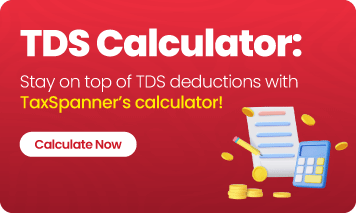Section 194IB under the Income Tax Act & TDS deduction under Section 194IB
The 2017 Budget expanded TDS on rent by introducing Section 194IB. Previously, only those subject to audits under Section 44AB were required to deduct TDS on rent under Section 194-I. This limited the scope of TDS, as many rent payers did not fall under this audit requirement. Section 194IB broadens this scope to increase tax revenue.
Section 194IB
Section 194IB requires individuals and Hindu Undivided Families (HUFs) paying monthly rent exceeding Rs. 50,000 to a resident Indian to deduct Tax Deducted at Source (TDS). This regulation applies only if the payer is not already subject to tax audits. The TDS rate is 5% of the rent if the landlord provides their PAN, and 20% if they don't. However, the deducted TDS under section 194IB cannot exceed the previous month's rent.
TDS Deduction Under Section 194IB
TDS needs to be deducted earlier of the:
Rent for the Final Month: Credit or payment of rent for the last month of the year, or for the final month of tenancy if you leave the property before the year ends. OR
Time of Payment: This applies at the time of payment, regardless of the method used (cash, check, or any other means).
Rate of Tax:-
Regular Rate is 5%
The TDS rate is 20% in case the landlord does not provide their PAN. However, the amount of TDS deducted cannot be more than the rent paid in the last month of the previous year or the last month of tenancy.
Online TDS Payment Under Section 194IB
- Log in to your income tax account.
- Go to E-file and then go to E-Pay Tax.
- Choose New Payment and then select 26QC (TDS on Property Rent).
- Enter the landlord's details, including their address and PAN. Provide information about the rent paid and the TDS deducted. Pay the tax.
- Save the payment acknowledgment number. Download and print Form 26QC for your records.
- Give the landlord Form 16C as proof of your tax payment, which they can use for their tax filing.
Difference Between Section 194IB An Section 194-I
- Sec 194IB applies to individual and HUFs not liable to Tax audit, whereas Sec 194I applies to Individual, HUFs, Companies and other
- Sec 194IB considers rental income paid for residential purposes of land and Building, whereas 194IB considers for both Residential and Commercial.
- In Sec 194IB TDS is deducted on rental payment above Rs.50000, whereas in 194I it is on payments above Rs.2,40,000
- TDS rate in 194IB is 5% and in 194I it is 10% for commercial and 2 % for residential purposes.
- TAN is not required in194IB, whereas TAN required in 194 I.
Form 26QC
Form 26QC is a combined challan and statement. If you've deducted tax under Section 194IB, you must deposit this tax using this form. The deposited TDS must be submitted within 30 days of the month-end when the tax was deducted, along with the completed Form 26QC.
Form 26 QC generally submitted at end of FY, however in some cases it must be filed early in these cases:
Early Vacancy: When leaving the property before the year ends.
Multi-Year Agreements: At the end of each financial year covered by the agreement.
Form 16C
Just as Section 194IB was introduced, Form 16C was also created. It's essentially a TDS certificate, similar to Forms 16 and 16A, issued by the tenant to the landlord. This certificate confirms that the tenant has deposited the TDS deducted under Section 194IB with the government. Importantly, the tenant must issue Form 16C within 15 days of filing the tax payment challan (Form 26QC).
Implications Of Not Complying With Provisions
General Provisions:
No TDS Deduction: If you fail to deduct TDS when required, you may be subject to a penalty.
Late TDS Deduction: You may be charged a 1% per month penalty interest on the unpaid tax from the date it should have been deducted until the actual deduction date.
Late TDS Payment: If you deduct TDS but don't pay it to the government on time, you may be charged a 1.5% per month penalty interest from the date of deduction until the actual payment date.
Specific Provisions:
Late Form 26QC Filing: A penalty of Rs. 200 per day may be imposed for late filing of Form 26QC. However, the total penalty cannot exceed the amount of TDS deducted.
Late Form 16C Issuance: A penalty of Rs. 100 per day may be levied for delayed issuance of Form 16C to the landlord. The maximum penalty amount is limited to the TDS amount.
Difference Between Section 194-I And Section 194IB
Sec 194IB is applicable to Individuals and HUFs paying rent over Rs.50000/month, whereas 194 I applies to any person (excluding specific Individuals and HUFs) paying rent over Rs.2,40,000/year.
TDS rate in Sec 194 IBis 2%, whereas in Sec 194 I it is 10% for land and building and 2% for machinery.
In Sec 194IB if PAN not provided TDS rate is 205, whereas in Sec 194 I it will be higher
In Sec 194IB return to be filed 30th april of next FY, while in 194 I it is to be filed by 7th and 30th of next month.
Explore TaxSpanner's wide range of calculators for your tax planning and calculations!
View Tools & Calculators





